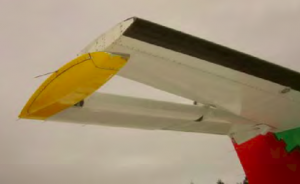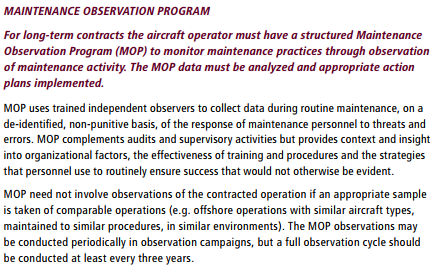Critical Maintenance Tasks: EASA Part -M & -145 Change
Commission Regulation (EU) 2015/1536 was issued on of 16 September 2015. Technically it amends Regulation (EU) No 1321/2014 “as regards alignment of rules for continuing airworthiness with the ‘Basic Regulation’ Regulation (EC) No 216/2008“.
Critical Maintenance Tasks (CMTs)
One of the most important parts of the amendment relates to CMTs, which are defined as:
…a maintenance task that involves the assembly or any disturbance of a system or any part on an aircraft, engine or propeller that, if an error occurred during its performance, could directly endanger the flight safety.
The European Aviation Safety Agency (EASA) has said that this change:
…addresses a safety issue related to the risk of errors made during the performance of critical maintenance tasks and the need for maintenance organisations to implement methods to capture those errors before the certificate of release to service is issued.
The change primarily enhances M.A.402 for Continuing Airworthiness Management Organisations (CAMOs). It also introduces 145.A.48 on the Performance of Maintenance for maintenance organisations (with 145.A.65(b) adjusted to be consistent with 145.A.48), which include tool control. Previously the expectation would be that the CAMO would ensure that M.A.402 defined standards were achieved by the maintenance organisation. Now effectively they are both accountable, the Part-145 to ensure the requirements are met and the Part-M to assure they are. Note: M.A.402 (a) previously referred to ‘flight safety sensitive maintenance tasks’ and 145.A.65 (b)(3) to ‘critical systems’.
For background and the history of the rule making see:
-
Terms of Reference for the Rule Making Team: Review Group ToR RMT.0222 (MDM.020) – Issue 1
-
Notice of Proposed Amendment: NPA 2012-04
-
Comment Response Document: CRD 2012-04 (193 comments were received)
The NPA was in part prompted by following three safety recommendations addressed to the Agency:
- AIBN recommendation 12/2006, Report on the aircraft accident at Bergen Airport Flesland, Norway, on 31 January 2005 involving ATR 42-320, OY-JRJ, operated by Danish Air Transport, when control problems were experienced an elevator bolts loosened and fell out. The self-locking nuts were not tightened with the required torque.
- UK AAIB Safety Recommendation 2005-123 in Report 3/2005 on the serious incident to Boeing 757-236 G-CPER, operated by British Airways, on 7 September 2003. Maintenance errors that had culminated in the failure to reinstall two access panels on the right-hand outboard flap and incorrect engine oil top up.
- UK AAIB Safety Recommendation 2006-030 AAIB Bulletin: 11/2006 EW/C 2004/10/03 on the fatal accident to a privately operated Mooney Aircraft Corporation M20J, G-EKMW. A defect was discovered within the engine’s dual magneto, which had recently been refitted following a 500 hour inspection, affecting both ignition systems. This led to a loss of power shortly after take off and the aircraft impacting the ground while attempting to return to the airfield
When discussed at the EASA Management Board, issue of whether the Type Certificate Holder was better placed to identify critical tasks. EASA clarified that this text is dealing with errors that occur during performance of maintenance, hence the responsibility is a continuing airworthiness one.
The associated AMC and GM is expected to be published this autumn. However CRD 2012-04 indicates what can be expected. In particular the AMC and GM to 145.A.48 will cover implementing maintenance error capturing methods, that may include Independent Inspections and other techniques such as functional checks.
Other Changes
Although we don’t plan to look at these in detail, the other changes include an aircraft continuing airworthiness monitoring (ACAM) requirement of regulators, a new Part-T and introduction of the term Complex Motor Powered Aircraft (CMPA) in place of large aircraft.
The ACAM primarily involves a change to M.B.303 that:
The competent authority shall develop a survey programme on a risk-based approach to monitor the airworthiness status of the fleet of aircraft on its register.
These surveys are physical aircraft inspections over and above those done in regulatory organisational audits, internal audits and the Airworthiness Review Certificate (ARC) process.
Part-T relates to the continuing airworthiness of aircraft leased by an EU operator that are on a non-EU register.
UPDATE 11 July 2016: EASA publish ED Decision 2016/011/R (Acceptable Means of Compliance and Guidance Material to Annex I (Part-M), Annex II (Part-145), Annex III (Part-66) and Annex Va (Part-T) to Commission Regulation (EU) No 1321/2014)
UPDATE 24 August 2016: UK CAA publish a reminder of changes coming into force tomorrow: IN-2016/077: Changes to Part-M and Part-145 Effective 25 August 2016
UPDATE 30 December 2016: This was our 7th most popular article in 2016, even though published in 2015!
Aerossurance is proud to have sponsored a 2015 Royal Aeronautical Society (RAeS) seminar, Maintenance Human Factors: The Next Generation, at Cranfield University. Presentations from that seminar are available here. Aerossurance has previously written about a number of relevant safety, maintenance human factors and continuing airworthiness issues:
- Professor James Reason’s 12 Principles of Error Management
- How To Develop Your Organisation’s Safety Culture
- Fatal $16 Million Maintenance Errors
- Inadvertent Fire Bottle Discharge During Maintenance
- FOD Damages 737 Flying Controls
- Cessna Citation Excel Controls Freeze
- B767 Engine Fire – Ignition from Misrouted / Chaffed Cables
- A319 Double Cowling Loss and Fire – AAIB Report
- Loose B-Nut: Accident During Helicopter Maintenance Check Flight
- USAF RC-135V Rivet Joint Oxygen Fire
- The Missing Igniters: Fatigue & Management of Change Shortcomings
- UPDATE 19 October 2015: Aircraft Maintenance: Going for Gold?
- UPDATE 23 November 2015: Misassembled Anti-Torque Pedals Cause EC135 Accident
- UPDATE 16 February 2016: EC130B4 Accident: Incorrect TRDS Bearing Installation
- UPDATE 31 January 2017: Airworthiness Matters: Next Generation Maintenance Human Factors
- UPDATE 21 March 2017: Director of Maintenance Pleads Guilty To Obstructing an NTSB Air Accident Investigation
- UPDATE 26 March 2017: Cessna 208 Forced Landing: Engine Failure Due To Re-Assembly Error
- UPDATE 16 April 2017: Insecure Pitch Link Fatal R44 Accident
- UPDATE 10 May 2017: Bell 429 TR Pitch Change Link Bearing Failure
- UPDATE 25 May 2017: Maintenance Human Factors in Finnish F406 Landing Gear Collapse
- UPDATE 3 April 2018: Hoist Assembly Errors: SAR Personnel Dropped Into Sea
- UPDATE 19 May 2018: Too Rushed to Check: Misrigged Flying Controls
- UPDATE 24 June 2018: B1900D Emergency Landing: Maintenance Standards & Practices The TSB report posses many questions on the management and oversight of aircraft maintenance, competency and maintenance standards & practices. We look opportunities for forward thinking MROs to improve their maintenance standards and practices.
- UPDATE 25 August 2018: Crossed Cables: Colgan Air B1900D N240CJ Maintenance Error On 26 August 2003 a B1900D crashed on take off after errors during flying control maintenance. We look at the maintenance human factor safety lessons from this and another B1900 accident that year.
- UPDATE 9 February 2019: Meeting Your Waterloo: Competence Assessment and Remembering the Lessons of Past Accidents: No one was injured in this low speed derailment in London after signal maintenance errors but investigators expressed concern that the lessons about maintenance errors from the fatal triple collision at Clapham in 1988 may have been forgotten.
- UPDATE 19 April 2019: FAA Rules Applied: So Misrigged Flying Controls Undetected in an accident to a Cessna 172 in Bermuda.
- UPDATE 6 October 2019: Glider Controls Fail After Non Compliant Maintenance Embodying an AD
- UPDATE 30 October 2019: ‘Crazy’ KC-10 Boom Loss: Informal Maintenance Shift Handovers and Skipped Tasks
- UPDATE 7 December 2019: Luftwaffe VVIP Global 5000 Written Off After Flying Control Assembly Error
Also:
UPDATE 31 May 2019: The Portuguese accident investigation agency, GPIAAF, issued a safety investigation update on a serious in-flight loss of control incident involving Air Astana Embraer ERJ-190 P4-KCJ that occurred on 11 November 2018. The aircraft was landed safely after considerable difficulty, so much so the crew had debated ditching offshore. GPIAAF conformed that incorrect ailerons control cable system installation had occurred in both wings during a maintenance check conducted in Portugal.
GPIAFF note that: “By introducing the modification iaw Service Bulletin 190-57-0038 during the maintenance activities, there was no longer the cable routing and separation around rib 21, making it harder to understand the maintenance instructions, with recognized opportunities for improvement in the maintenance actions interpretation”. They also comment that: “The message “FLT CTRL NO DISPATCH” was generated during the maintenance activities, which in turn originated additional troubleshooting activities by the maintenance service provider, supported by the aircraft manufacturer. These activities, which lasted for 11 days, did not identify the ailerons’ cables reversal, nor was this correlated to the “FLT CTRL NO DISPATCH” message.”
GPIAFF comment “deviations to the internal procedures” occurred within the maintenance organisation that “led to the error not being detected in the various safety barriers designed” in the process. They also note that the error ” was not identified in the aircraft operational checks (flight controls check) by the operator’s crew.”
UPDATE 1 June 2019: Our analysis: ERJ-190 Flying Control Rigging Error
UPDATE 9 May 2020: Ungreased Japanese AS332L Tail Rotor Fatally Failed
Aerossurance worked with the Flight Safety Foundation (FSF) to create a Maintenance Observation Program (MOP) requirement for their contractible BARSOHO offshore helicopter Safety Performance Requirements to help learning about routine maintenance and then to initiate safety improvements:
Aerossurance can provide practice guidance and specialist support to successfully implement a MOP.
Aerossurance is pleased to be both sponsoring and presenting at a Royal Aeronautical Society (RAeS) Human Factors Group: Engineering seminar Maintenance Error: Are we learning? to be held on 9 May 2019 at Cranfield University.
UPDATE 15 January 2016: The UK Civil Aviation Authority (CAA) has finally published CAP1367: Aircraft Maintenance Incident Analysis. The CAA say CAP1367:
…seeks to provide information on the common causes where maintenance error has been a contributory factor in incidents and occurrences reported to the CAA. The aim is to provide industry with a more up to date set of data which they can review and, where appropriate, use to complement their own analyses as part of their Safety Management Systems and Human Factors Continuation Training Programmes.
Unfortunately, in relation to providing an ‘up to date set of data’, this report, originally due for publication in 2013, was delayed until now and only includes data up to 2011.
UPDATE 2 March 2018: An excellent initiative to create more Human Centred Design (HCD) by use of a Human Hazard Analysis (HHA) is described in Designing out human error
HeliOffshore, the global safety-focused organisation for the offshore helicopter industry, is exploring a fresh approach to reducing safety risk from aircraft maintenance. Recent trials with Airbus Helicopters and HeliOne show that this new direction has promise. The approach is based on an analysis of the aircraft design to identify where ‘error proofing’ features or other mitigations are most needed to support the maintenance engineer during critical maintenance tasks.
The trial identified the opportunity for some process improvements, and discussions facilitated by HeliOffshore are planned for early 2018.
Aerossurance was pleased to sponsor the 2017 European Society of Air Safety Investigators (ESASI) 8th Regional Seminar in Ljubljana, Slovenia on 19 and 20 April 2017. ESASI is the European chapter of the International Society of Air Safety Investigators (ISASI).
Aerossurance sponsored an RAeS HFG:E conference at Cranfield University on 9 May 2017, on the topic of Staying Alert: Managing Fatigue in Maintenance.
Aerossurance is pleased to be supporting the annual Chartered Institute of Ergonomics & Human Factors’ (CIEHF) Human Factors in Aviation Safety Conference for the third year running. We will be presenting for the second year running too. This year the conference takes place 13 to 14 November 2017 at the Hilton London Gatwick Airport, UK with the theme: How do we improve human performance in today’s aviation business?






Recent Comments